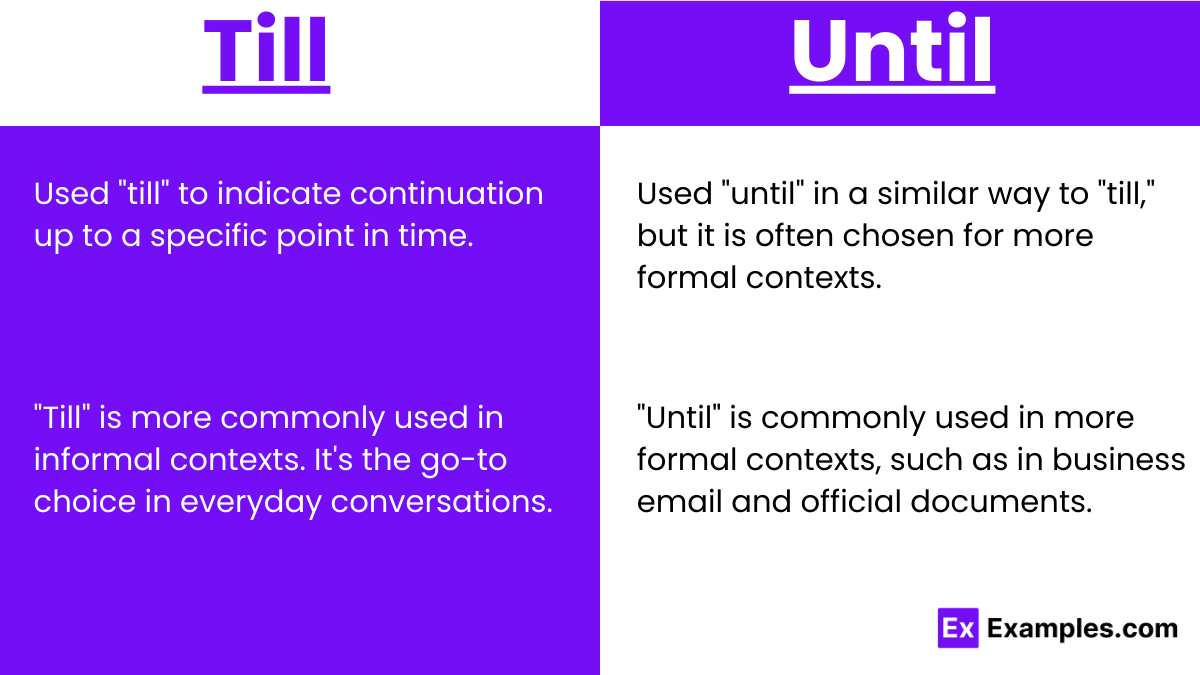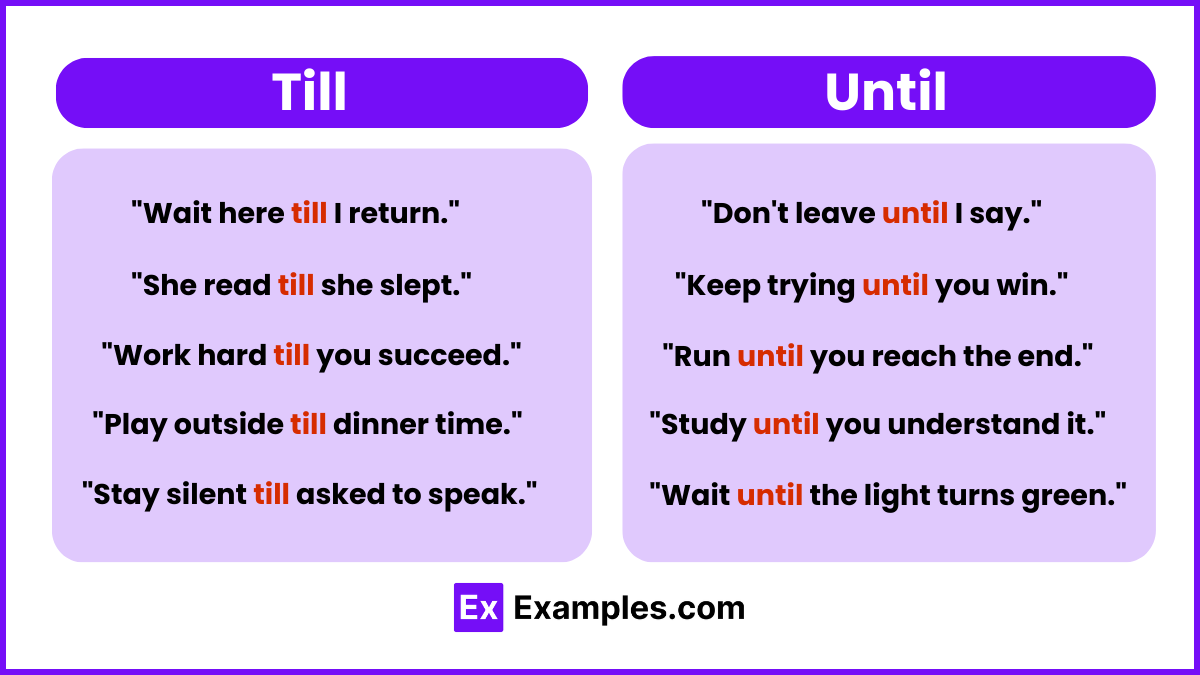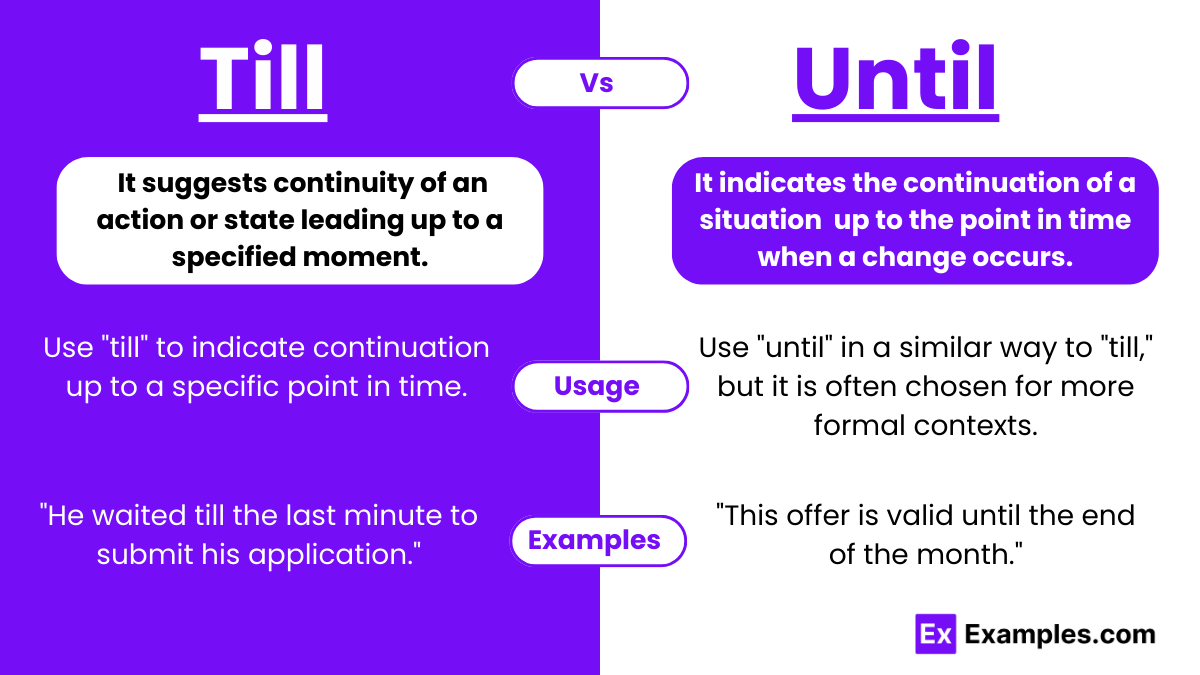Till vs Until – Difference, Meanings, Examples, Usage
The journey of mastering the English Language can be daunting, with its vast grammar rules and extensive vocabulary. Till surfaces as a more casual term, often used in everyday conversations. Until, on the other hand, bears a slightly more formal tone, frequently appearing in written texts. However, learning the specific uses of words like ‘till‘ and ‘until‘ can demystify language complexities, making it more accessible. This guide aims to simplify these terms, offering clear insights into their usage, ensuring students feel confident in their application.
Till vs Until – Meanings
Till and Until are both prepositions and conjunctions used to indicate the time up to which an event or action is to continue. However, they are used in slightly different contexts or for stylistic variation.
- Till: Often considered more informal, “till” is used to denote a period up to a certain point in time. It suggests continuity of an action or state leading up to a specified moment.
- Until: “Until” is typically used in more formal or written English. It indicates the continuation of a situation or action up to the point in time when a change occurs.
Summary
Both “till” and “until” are used to denote the duration of time up to a certain point. For example, “I will wait till/until 6 PM.” The choice between “till” and “until” often depends on the speaker’s preference or the formality of the context, with “until” being slightly more formal. However, they are generally interchangeable without a significant difference in meaning.
How to Pronounce Till and Until
- Till: Pronounced as /tɪl/ (til).
- Until: Pronounced as /ənˈtɪl/ (uhn–til).
Differences between Till and Until
| Aspect | Till | Until |
|---|---|---|
| Formality | Considered less formal, more common in casual or spoken English. | Generally more formal, widely used in both spoken and written English. |
| Origin | Originates from the Old English word “til”, implying reaching to a point. | Derives from “till” with the Old Norse prefix “un-” added, meaning “up to”. |
| Position in Sentence | Less commonly used at the beginning of sentences. | More versatile, often used at the beginning of sentences. |
| Common Combinations | Frequently paired with “from” to denote a start and end point (e.g., “from dawn till dusk”). | Used alone to indicate the duration up to a point (e.g., “until midnight”). |
How to Remember the Difference between Till and Until
A simple trick to remember the difference between “till” and “until” is to associate “until” with formal situations and “till” with casual ones. Think of “until” wearing a suit, fitting well in formal writing and official communications. Meanwhile, envision “till” in casual attire, relaxed and often used in everyday conversations and informal writing. This imagery can help you decide which to use based on the tone you want to convey.
When to Use Till and Until

Usage of Till
- Use “till” to indicate continuation up to a specific point in time.
- Casual Writing: Suitable for informal texts and dialogues.
- Informality: “Till” is more commonly used in informal contexts. It’s the go-to choice in everyday conversations and less formal writing. This doesn’t mean it’s incorrect in formal writing, but it tends to appear more frequently in casual exchanges.
- Less Common at Sentence Start: Starting sentences with “till” is less usual. While not incorrect, it’s more common to see “till” used in the middle or at the end of sentences. For instance, it’s typical to place “till” after the subject and main verb in a sentence.
- Flexibility in Speech: In spoken English, “till” is often used for its brevity and familiarity. It fits well in rapid, natural dialogue where conciseness and ease of understanding are valued.
Usage of Until
- Use “until” in a similar way to “till,” but it is often chosen for more formal contexts.
- Usage in Formal Writing: “Until” is commonly used in more formal contexts, such as in business emails, academic papers, and official documents.
- Starting Sentences: It’s completely acceptable and quite common to use “until” at the beginning of a sentence to set the timeframe for the subsequent action or state.
- Versatility: “Until” can be used in various situations without much restriction, whether it’s to talk about time, conditions, or situations.
- No Abbreviation: Unlike “till”, which can be shortened to “’til” in informal writing, “until” is generally not abbreviated, maintaining its formality.
- Widely Accepted: “Until” is universally understood and accepted in both American and British English without any preference or variation in meaning.
Till and Until – Examples

Till Examples
- “We need to stay here till the rain stops.”
- “She worked till late at night to finish the project.”
- “I’ll be in the office till five o’clock.”
- “The shop is open till 9 PM.”
- “He waited till the last minute to submit his application.”
Until Examples
- “I will be busy until 3 PM.”
- “The park is open daily until dusk.”
- “We cannot begin the ceremony until everyone has arrived.”
- “This offer is valid until the end of the month.”
- “He didn’t realize his mistake until it was too late.”
Synonyms
| Till/Until | Synonyms |
|---|---|
| Till | Up to, by the time, to, through to |
| Until | Up to the time of, to the point of, through, up until, before |
Exercise
- The library is open ____ 8 PM on weekdays.
- We should not leave ____ we hear back from the team.
- Can you wait here ____ I grab my coat?
- The discount is applicable ____ the end of this week.
- She won’t be back ____ tomorrow morning.
Answers
- till/until
- until
- till/until
- until
- until
FAQ’S
Why Do People Use Till Instead of Until?
Till is often used as a shorter, more casual form of until, offering simplicity in conversation and writing.
Is It Till or Until Friday?
Both till Friday and until Friday are correct, but until is more formal.
What Is the Difference Between Till, Still, and Until?
Till and until denote time up to a point, while still indicates ongoing action or state.
Is It Till Tomorrow or Until Tomorrow?
Either till tomorrow or until tomorrow can be used, with until being slightly more formal.
Is It Up Till Now or Until Now?
Both up till now and until now are acceptable, but until now is more common in formal contexts.


